Lea Wait's Blog, page 86
June 27, 2022
The Introvert’s Hangover™
 Before I get yammering here, please wish my good wife and the only person left in the world who laughs at my jokes, a happy birthday. She is XX years old.
Before I get yammering here, please wish my good wife and the only person left in the world who laughs at my jokes, a happy birthday. She is XX years old.
I woke up last Sunday morning feeling a little tired and cranky. This was not my usual fifteen minutes of moving my joints and brain enough to turn on the coffee pot, but a deeper fatigue, almost exhaustion. If I were still a drinking man, I would have put it down to excess, but a glass or two of wine is the extent of my dissolution these days.
It wasn’t until Anne asked me how Crime Wave went that I realized what I had was the Introvert’s Hangover .
.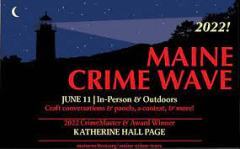
If you’re not familiar with it, Crime Wave is Maine’s annual writing conference devoted to crime, suspense, and mystery fiction, with panels, interviews, and a good deal of schmoozing. It was staged in Portland on June 11, spanning an entire Saturday, and for many of us, was the first large scale in-person event we’ve been to in two years or more. You could see it in the tentativeness of hugs and handshakes, the occasional mask, even though we met outside under the tent.
(And many thanks to USM, MWPA, Sisters in Crime, and the folks who worked to make the day a success.)
But an entire day? After a couple of years of Zooming, the occasional outside walk with a friend or two? An entire day, with scores of people?
Despite what all you sociable, outgoing bubbly types might think, introverts do not dislike people or their company. Many of us like the occasional buzz of connection, conversation, and colloquy.  But for most introverts, that takes much more energy, much more work than it does for more extroverted types.
But for most introverts, that takes much more energy, much more work than it does for more extroverted types.
Add to this the fact that there were many people for whom this was their first Crime Wave. Interacting with new people takes even more energy than reconnecting with old friends.
The whole thing bore an emotional content for me, too: gratitude for having survived the pandemic (so far), an acknowledgment of the privilege we have to expend our energy on something as essentially frivolous as writing crime fiction, and the pleasure of being outdoors on a rare beautiful Maine spring day.
So yes, come Sunday, I had a hangover. But I don’t regret it a bit, any more than any other hangover I’ve ever had, except maybe the one in 1974 from gin and grapefruit juice. The fatigues and crankiness will recede eventually and sooner or later, I should be ready to come out and play again.
In other news, yes, I have another book coming out. This one, The Last Altruist, is not an Elder Darrow book.  It’s set in southern Maine and tells the story of a returning war veteran, Ardmore Theberge, dishonorably discharged from the Army for beating up a superior officer. He befriends a local store owner, under pressure to sell her building, and her mentally challenged son, Robbie. When a real estate developer is killed and it looks as if Robbie did it, Ardmore steps in to protect the boy. Here’s a look at the cover.
It’s set in southern Maine and tells the story of a returning war veteran, Ardmore Theberge, dishonorably discharged from the Army for beating up a superior officer. He befriends a local store owner, under pressure to sell her building, and her mentally challenged son, Robbie. When a real estate developer is killed and it looks as if Robbie did it, Ardmore steps in to protect the boy. Here’s a look at the cover.
Not yet, but soon, you will be able to preorder from Kelly’s Books to Go or your favorite independent source.
June 24, 2022
Weekend Update: June 25-26, 2022
 Next week at Maine Crime Writers there will be posts by Maureen Milliken (Monday), Dick Cass (Tuesday), Matt Cost (Thursday), and Kaitlyn Dunnett/Kathy Lynn Emerson (Friday).
Next week at Maine Crime Writers there will be posts by Maureen Milliken (Monday), Dick Cass (Tuesday), Matt Cost (Thursday), and Kaitlyn Dunnett/Kathy Lynn Emerson (Friday).
In the news department, here’s what’s happening with some of us who blog regularly at Maine Crime Writers:
On June 11th, many of us gathered in Portland for the Maine Crime Wave. It was exciting to be together in person again. To meet new authors and to see some of our regulars as well as many alums of the blog. Sorry you missed it? Stay tuned for next year. It is always great to hear writers on writing, as well as hilarious panels where the authors lie about their adventures in research and publishing.
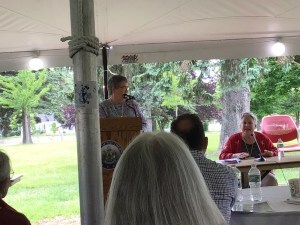
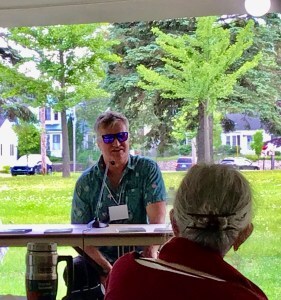
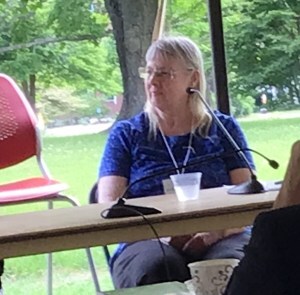
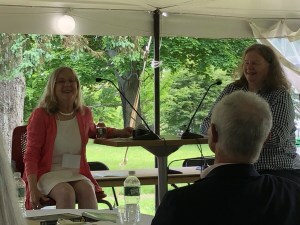
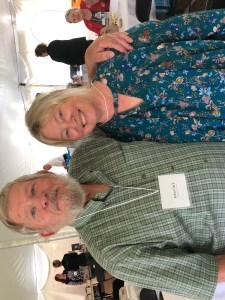
An invitation to readers of this blog: Do you have news relating to Maine, Crime, or Writing? We’d love to hear from you. Just comment below to share.
And a reminder: If your library, school, or organization is looking for a speaker, we are often available to talk about the writing process, research, where we get our ideas, and other mysteries of the business, along with the very popular “Making a Mystery” with audience participation, and “Casting Call: How We Staff Our Mysteries.” We also do programs on Zoom. Contact Kate Flora
June 23, 2022
Rejection. Rejections. And Blizzard Therapy
I want to talk about rejections.
On Facebook and Instagram, and Twitter and these public places, we don’t usually hear about gut-wrenching stuff. These sites are perhaps how we market ourselves to the world. How we manage the front window of our lives and perhaps pull the curtain on the back room which might be darker and certainly messier.
I’m not saying what is shared out there isn’t genuine. These sharings simply seem selective as in … no one wants to hear someone whine.
I won’t go back too far, just to my last bout of job hunting (2008-2010) and then a bit of feedback as I shopped around my first novel. One led to the other. At the age of sixty-three (2009), when I seemed suddenly unemployable, my soon-to-be husband said, “Ok. Write the book. I’ll pay for vet bills and food.”
I’ll pay for vet bills and food.”
And I won’t try to say that rejection is a healthy thing that sets us on a better road or is a gift. That feels glib. Rejections hurt. And when they pile up like during my job-hunting failures and then my attempts to find representation as well as sell the novel, they deliver messages that take grit and courage to face the messages they deliver.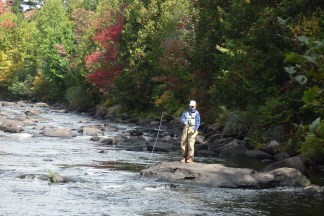
Fact to Face: You are now probably too old to compete with job candidates fifteen to twenty years younger in a Maine job market swamped with qualified younger applicants.
Job Rejection Letters (just a few here):
“My apologies for the length of time in getting back to you. We received 67 applications for the E.D. position, and the process has taken longer than we anticipated. You were among the top eight candidates, but we initially chose to interview a smaller number whose experiences most closely matched IHE’s needs.”
“The number of highly qualified applications that we’ve received has been truly remarkable. We wanted you to know that, while we were impressed with your skills, experience and genuine interest in working for MITA, our Search Committee is pursuing other candidates at this time.”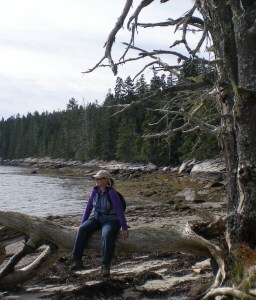
“As an organization we were flattered to see such interest in our Coalition and this position. We received a large number of very qualified applicants and this made our selection process more difficult.”
“I wanted to thank you again for talking the time to interview with us for the Director of Marketing position. I was frankly overwhelmed by the number of highly qualified individuals who applied for the job. Given this fact, we had a difficult decision to make, but we have offered the job to another candidate and they have accepted.”
Fact to Face: Even with an agent, my novel is not going to get picked up by a national or even a Maine publisher.
Book Rejections (just a few here; usually email)
“I also loved the concept for WOLF WOODS — as you know, we’ve done incredibly well with Margaret Mizushima’s novels, which have a similar concept, and I adore Maine and the idea of setting a thriller there. Try as I might, though, I just didn’t fall in love with Patton in the way I would need to in order to be able to make an offer on this.”
“The plot was great, but it took much too long to get into it. Too many detailed descriptive passages and tangents detracted from the main plot. I found myself trying to skip ahead and bypass the unnecessary prose.”
“I think the author has an interesting idea here and certainly can write, but I’m sorry to say that the story didn’t resonate in the way I had hoped.”
“She knows her territory, and I enjoyed her descriptions of Maine.  However, I didn’t find the murder as believable as I’d need to get invested in the mystery. I’m sorry that this one isn’t for me, but thanks for giving me a chance with it.”
However, I didn’t find the murder as believable as I’d need to get invested in the mystery. I’m sorry that this one isn’t for me, but thanks for giving me a chance with it.”
Did I stop job hunting? Yes. I stopped applying for career-level jobs but pursued seasonal work like the front desk at the Botanical Gardens.
Did I stop trying to sell the novel? No, but I moved over to co-op publishing or “pay to play” where I paid for most of the same services a small Indie publisher might offer me. (Great help: Jane Friedman’s chart.)
Did all this sink me? Sometimes, but my mode-altering drug of choice is the outdoors … with me in it. Yes, sometimes I sank as low as a fetal, rolled up ball on the floor, but then I have dogs that lay their heads in my lap and lick my tears and say (quite selfishly) “You done? Let’s go out.”
If we are still standing, we have our survival strategies, but rejection is still often a life altering event. Piled on repeatedly, it demands survival strategies, friendships, grit, and often a renewed faith in ourselves when the rest of the world is rejecting us. 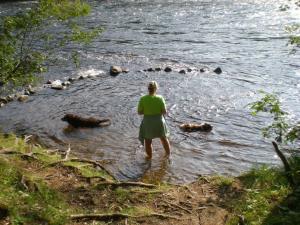
And for me, there’s nature’s feel-good message after a blizzardy ski or a hike where legs get wobbly before the car appears, or unexpected wind makes the paddle home a wrestle with the lake.
That’s when I am in a full-on acceptance mode, far beyond any hint of rejection and I can honestly say what really matters: “Damn, I’m good.” 
*************************
PS Just for fun: famous rejections: Marcel Proust had to pay for his own publication.Zen and the Art of Motorcycle Maintenance by Robert M. Pirsig was rejected 121 times before it was published.Animal Farm by George Orwell was rejected because “there is no market for animal stories in the USA.”J. K. Rowling of Harry Potter fame was told “not to quit her day job.” Gone with the Wind by Margaret Mitchell was rejected 38 times before it was published.John le Carré’s The Spy Who Came in from the Cold was passed on because le Carré “hasn’t got any future.”
Gone with the Wind by Margaret Mitchell was rejected 38 times before it was published.John le Carré’s The Spy Who Came in from the Cold was passed on because le Carré “hasn’t got any future.”Sandy’s debut novel, “Deadly Trespass, A Mystery in Maine” won a national Mystery Writers of America award, was a finalist in the Women’s Fiction Writers Association “Rising Star” contest, and was a finalist for a Maine Literary Award. The second Mystery in Maine, “Deadly Turn,” was published in 2021. Her third “Deadly” is due out in 2022. Find her novels at all Shermans Books (Maine) and on Amazon. Find more info on Sandy’s website.
Rejection. Rejections.
I want to talk about rejections.
On Facebook and Instagram, and Twitter and these public places, we don’t usually hear about gut-wrenching stuff. These sites are perhaps how we market ourselves to the world. How we manage the front window of our lives and perhaps pull the curtain on the back room which might be darker and certainly messier.
I’m not saying what is shared out there isn’t genuine. These sharings simply seem selective as in … no one wants to hear someone whine.
I won’t go back too far, just to my last bout of job hunting (2008-2010) and then a bit of feedback as I shopped around my first novel. One led to the other. At age of sixty-three (2009), when I seemed suddenly unemployable, my soon-to-be husband said, “Ok. Write the book. I’ll pay for vet bills and food.”
I’ll pay for vet bills and food.”
And I won’t try to say that rejection is a healthy thing that sets us on a better road or is a gift. That feels glib. Rejections hurt. And when they pile up like during my job-hunting failures and then my attempts to find representation as well as sell the novel, they deliver messages that take grit and courage to face the messages they deliver.
Fact to Face: You are now probably too old to compete with job candidates fifteen to twenty years younger in a Maine job market swamped with qualified younger applicants.
Job Rejection Letters (just a few here):
“My apologies for the length of time in getting back to you. We received 67 applications for the E.D. position, and the process has taken longer than we anticipated. You were among the top eight candidates, but we initially chose to interview a smaller number whose experiences most closely matched IHE’s needs.”
“The number of highly qualified applications that we’ve received has been truly remarkable. We wanted you to know that, while we were impressed with your skills, experience and genuine interest in working for MITA, our Search Committee is pursuing other candidates at this time.”
“As an organization we were flattered to see such interest in our Coalition and this position. We received a large number of very qualified applicants and this made our selection process more difficult.”
“I wanted to thank you again for talking the time to interview with us for the Director of Marketing position. I was frankly overwhelmed by the number of highly qualified individuals who applied for the job. Given this fact, we had a difficult decision to make, but we have offered the job to another candidate and they have accepted.”
Fact to Face: Even with an agent, my novel is not going to get picked up by a national or even a Maine publisher.
Book Rejections (just a few here; usually email)
“I also loved the concept for WOLF WOODS — as you know, we’ve done incredibly well with Margaret Mizushima’s novels, which have a similar concept, and I adore Maine and the idea of setting a thriller there. Try as I might, though, I just didn’t fall in love with Patton in the way I would need to in order to be able to make an offer on this.”
“The plot was great, but it took much too long to get into it. Too many detailed descriptive passages and tangents detracted from the main plot. I found myself trying to skip ahead and bypass the unnecessary prose.”
“I think the author has an interesting idea here and certainly can write, but I’m sorry to say that the story didn’t resonate in the way I had hoped.”
“She knows her territory, and I enjoyed her descriptions of Maine.  However, I didn’t find the murder as believable as I’d need to get invested in the mystery. I’m sorry that this one isn’t for me, but thanks for giving me a chance with it.”
However, I didn’t find the murder as believable as I’d need to get invested in the mystery. I’m sorry that this one isn’t for me, but thanks for giving me a chance with it.”
Did I stop job hunting? Yes. I stopped applying for career-level jobs but pursued seasonal work like the front desk at the Botanical Gardens.
Did I stop trying to sell the novel? No, but I moved over to co-op publishing or “pay to play” where I paid for most of the same services a small Indie publisher might offer me. (Great help: Jane Friedman’s chart.)
Did all this sink me? Sometimes, but my mode-altering drug of choice is the outdoors … with me in it. Yes, sometimes I sank as low as a fetal, rolled up ball on the floor, but then I have dogs that lay their heads in my lap and lick my tears and say (quite selfishly) “You done? Let’s go out.”
If we are still standing, we have our survival strategies, but rejection is still often a life altering event. Piled on repeatedly, it demands survival strategies, friendships, grit, and often a renewed faith in ourselves when the rest of the world is rejecting us. 
And for me, there’s nature’s feel-good message after a blizzardy ski or a hike where legs get wobbly before the car appears, or unexpected wind makes the paddle home a wrestle with the lake.
That’s when I am in a full-on acceptance mode, far beyond any hint of rejection and I can honestly say what really matters: “Damn, I’m good.” 
*************************
PS Just for fun: famous rejections: Marcel Proust had to pay for his own publication.Zen and the Art of Motorcycle Maintenance by Robert M. Pirsig was rejected 121 times before it was published.Animal Farm by George Orwell was rejected because “there is no market for animal stories in the USA.”J. K. Rowling of Harry Potter fame was told “not to quit her day job.” Gone with the Wind by Margaret Mitchell was rejected 38 times before it was published.John le Carré’s The Spy Who Came in from the Cold was passed on because le Carré “hasn’t got any future.”Sandy’s debut novel, “Deadly Trespass, A Mystery in Maine” won a national Mystery Writers of America award, was a finalist in the Women’s Fiction Writers Association “Rising Star” contest, and was a finalist for a Maine Literary Award. The second Mystery in Maine, “Deadly Turn,” was published in 2021. Her third “Deadly” is due out in 2022. Find her novels at all Shermans Books (Maine) and on Amazon. Find more info on Sandy’s website.
Remembering those Long Ago Maine Summers
Kate Flora: I don’t know why I remember summers more than winters. Was it because
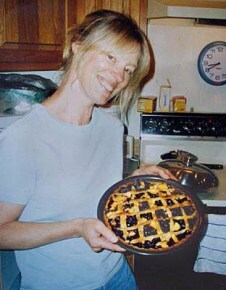
Pie from my Union blueberries.
school was out and there was so much more time for rambling? Because the days were so long and we could stay outside and play long after dinner? Somehow, the sights and smells of summer are so evocative. Over the past two day, I went rambling around Camden and Rockland with my childhood best friend and they all came rushing back.
I didn’t know it then, of course, but I was spoiled growing up where I did. Not because of things–we didn’t have things, we had bill collectors banging on the door and often worried about losing the phone or oil for the furnace–but because our 1811 farmhouse was perched on a hilltop looking down over rolling fields to a beautiful lake. Sunrise over the orchard and sunsets over the hills across the lake. Sometimes a night when we could lie out in the yard and see the Northern Lights.
We were spoiled because we had over a hundred acres to explore. We could stake out mossy plateaus along the cliffs in the woods and make them into our houses, our castles, our own worlds limited only by imagination. We were spoiled because both our parents were avid gardeners and the food we got to eat we grew ourselves and it tasted real. Because when we ate corn, Dad had just asked how many ears we wanted and gone down to the garden to pick them.
 Not that summers were ever a time of endless leisure, of course. It was a farm and there were always many chores to be done. On many days, the three of us, my brother John, my little sister Sara, and I were handed typed chore lists in the morning and those chores would have to be done before we could go down to the lake and swim. Laundry. Ironing. Vacuuming and dusting. Weeding the garden. Endless weeding the garden because weeds are always ahead of the crops. But then, like a school bell had rung, we could pull on yesterday’s damp bathing suit and race down the hills to the lake.
Not that summers were ever a time of endless leisure, of course. It was a farm and there were always many chores to be done. On many days, the three of us, my brother John, my little sister Sara, and I were handed typed chore lists in the morning and those chores would have to be done before we could go down to the lake and swim. Laundry. Ironing. Vacuuming and dusting. Weeding the garden. Endless weeding the garden because weeds are always ahead of the crops. But then, like a school bell had rung, we could pull on yesterday’s damp bathing suit and race down the hills to the lake.
Mom was awfully clever about getting us–and the friends who inevitably showed up when it was time to swim–to think that work was fun. Yes, we could swim, but before we did, everyone had to pick up twenty rocks from the lakebed and toss them onto the bank. Between this, and the many baskets of leaf mulch she pulled out and used on the gardens, she maintained a lovely open, sandy swimming area.
The days were never over when dinnertime rolled around. There was always something

From Mt. Megunticook to the sea
from the garden that needed to be processed. Peas to shell or beans to snap or cherries to be pitted. We would sit around the table, often with guests from New York or New Jersey joining in, and talk while we processed what needed to be canned or frozen for what we always called “the long, cold winter.”
One spring, we found that a float, or raft, had drifted into our cove from somewhere else on the lake. When no one came to claim it, my brother John and I made it our own. Often, after dinner, if there weren’t chores to be done, we would take our fishpoles and a long pole we used to steer the raft, and we would pole out into the lake and fish. There was a family of feral cats with many kittens that lived underneath the back porch. We would fill the box with little fish–perch or sunfish–then bring them back up the hill to the house where we would leave them for the cats.
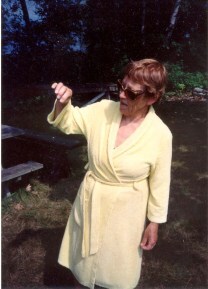
Mom in the yellow bathrobe we all wanted to burn
Often the long day would end with us swinging from the old apple tree in the backyard, or perched in the tree itself, as we watched the sun set behind the hill. After going to Boston for college and staying for many years, I’ve realized that my upbringing was very different from most of my friends and neighbors, and I’m grateful for it. I’m grateful that it has kept me attuned to the natural world in ways that many people aren’t.
Yesterday, driving from Rockland to Augusta, I was in a long stream of traffic on Route 17 caused by road construction. As we puttered past equipment and traffic cones, I was given the gift of seeing an eagle fly overhead. Would I have seen it if I weren’t so attuned to the world of a Maine summer?
June 20, 2022
Summertime Books
Ah, summer! It’s time for barbeque, beach, and, of course, books that bring us into the season. Here are a few notable ones: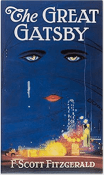
The Great Gatsby: F. Scott Fitzgerald creates an atmosphere that is literally and actually stifling – a claustrophobic, sticky heat. In fact, the whole plot of Gatsby mirrors summer. Tension mounts with the temperature, and the denouement comes with the first chill of fall.
Nemesis: Philip Roth explores the effects of a polio epidemic on a small Newar k community during the summer of 1944. By setting his novel in a season that should be fun and carefree for children, Roth manages to heighten the dark realities of polio for the children it struck: sickness, lifelong paralysis, and even death. Our own pandemic experience makes this very real.
k community during the summer of 1944. By setting his novel in a season that should be fun and carefree for children, Roth manages to heighten the dark realities of polio for the children it struck: sickness, lifelong paralysis, and even death. Our own pandemic experience makes this very real.
 Summer of ’69: Elin Hilderbrand welcomes us to one of the most tumultuous summer of the twentieth century. Every year the Levin children have looked forward to summer at their grandmother’s home in downtown Nantucket. But like so much else in America, nothing is the same: Blair, the oldest sister, is pregnant with twins and marooned in Boston. Middle sister Kirby, caught up in the thrilling vortex of civil rights protests and determined to be independent, takes a job on Martha’s Vineyard. Only-son Tiger is an infantry soldier just deployed to Vietnam.
Summer of ’69: Elin Hilderbrand welcomes us to one of the most tumultuous summer of the twentieth century. Every year the Levin children have looked forward to summer at their grandmother’s home in downtown Nantucket. But like so much else in America, nothing is the same: Blair, the oldest sister, is pregnant with twins and marooned in Boston. Middle sister Kirby, caught up in the thrilling vortex of civil rights protests and determined to be independent, takes a job on Martha’s Vineyard. Only-son Tiger is an infantry soldier just deployed to Vietnam.
As the summer heats up, Ted Kennedy sinks a car in Chappaquiddick, a man flies to the moon, and the Levins experience their own dramatic upheavals along with the rest of the country. In her first historical novel, rich with the details of an era that shaped both a nation and an island thirty miles out to sea, Elin Hilderbrand once again earns her title as queen of the summer novel.
To Kill A Mockingbird: Set in small-town Alabama, Mockingbird is a coming-of-age novel that chronicles the childhood of Scout and Jem Finch as their father Atticus defends a Black man falsely accused of rape. The book won the 1961 Pulitzer Prize and was later made into an Academy Award-winning film, also a classic.
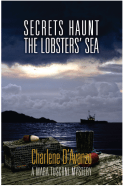 Secrets Haunt The Lobsters’ Sea: I’ll end with one of my own, a novel that features lobsters, of course, and the rough and tumble nature of Maine’s signature fishery. Along the way, readers experience summertime sea kayaking among the states’ many islands.
Secrets Haunt The Lobsters’ Sea: I’ll end with one of my own, a novel that features lobsters, of course, and the rough and tumble nature of Maine’s signature fishery. Along the way, readers experience summertime sea kayaking among the states’ many islands.
June 19, 2022
The Republic of Madawaska

Vaughn C. Hardacker
Vaughn Hardacker here: If only all wars could be like the Aroostook War, a boundary dispute fought mostly with fists rather than cannon. The conflict featured a battle broken up by a bear, an arrest over a homemade flag and soldiers who shivered in ridiculous uniforms. It was also known as the Pork and Beans War, either because of lumbermen’s diet or the British regulars’ rations.
The Aroostook War, which took place from 1838-39, involved timber-hungry Mainers and timber-hungry New Brunswickers. They squared off until Daniel Webster settled the whole thing. Though the conflict was more farce than war, the mythical Republic of Madawaska that started it is taken seriously by its inhabitants today.

Map of The Aroostook War
MADAWASKARobert Pike in Tall Trees, Tough Men characterized the Aroostook War as starting when ‘Maine carted a couple of brass cannon up north to shoot at Canadians stealing Maine timber.’
The trouble started when the Treaty of Paris ended the American Revolution, but left ambiguous the border between Maine, then a district, and the Canadian province of New Brunswick.
The Treaty of Ghent, which ended the War of 1812, still left the boundary unsettled. Conflict seemed inevitable as the British needed the tall pines along the St. John River for the navy’s masts. But the Americans had a voracious appetite for lumber as well.
People called the disputed land Madawaska, settled by French (Acadian) people. The French had little love for the British, who crowded them out of their land in Nova Scotia. They called themselves Les Brayons, and farmed peacefully. The lumbermen caused all the trouble, fighting among themselves for the best stands of trees.
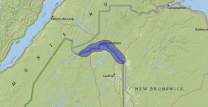
The_Republic_of_Madawaska
ENTER JOHN BAKERIn 1817, a settler named John Baker arrived in Madawaska with his family from Kennebec. Maine. He earned a reputation as ‘the Washington of the Republic of Madawaska.’Baker pursued his rights to the land as an American, and obtained a land grant north of the St. John River after Maine became a state in 1820. He built up a successful millworks, which still stands, in territory claimed by the British. The U.S. government recognized the British claim, but that didn’t stop Baker. On July 4, 1827, he hoisted a homemade flag his wife Sophronia had sewn with six stars above an American eagle. Baker declared the Republic of Madawaska an American republic. He then threw a party with Les Brayons and a French fiddler in what is now Baker-Brook, New Brunswick.
The Madawaska Flag flown during the Aroostook War.
The next month, John Baker declared American Aroostook Independence Day on Aug. 10, 1827. New Brunswick demanded Baker take down the flag. When he refused, they arrested him and hauled him off to a Fredericton jail. No sooner did he leave her sight than his wife hoisted another homemade flag.
A New Brunswick court tried Baker for conspiracy and sedition, convicted him, fined him, and sent him home. The U.S. government protested vigorously. Washington sent U.S. regulars to Houlton, and they began to build an invasion road and fort.
THE ROAD TO THE AROOSTOOK WARNegotiators appointed under the Treaty of Ghent had requested a survey of Madawaska. But according to local legend, the Americans got the British surveyors so drunk they surveyed the wrong river. In the end, the two sides couldn’t agree, so they appointed the King of the Netherlands umpire. His decision satisfied neither side.
Madawaska then organized a government under John Baker’s leadership and elected Pierre Lizotte, a Brayon, to represent them. Lizotte wisely rejected the honor because New Brunswick officials arrested, tried, and convicted people who voted.
The Maine Legislature subsequently retaliated by recognizing the Town of Madawaska. The ‘town’ measured three times the size of Rhode Island.
Tempers continued to flare. Fists flew, officials got arrested and tensions finally boiled over in 1838 with the Battle of Caribou… ‘Battle’ may be too strong a word. The only combat fatality at the Battle of Caribou — and in the whole of the Aroostook War — was a bear. On December 29, American woodcutters spotted New Brunswick lumbermen cutting down trees on an American’s estate. The American woodcutters rushed to stand guard, and a shouting match ensued. The lumbermen drew arms and prepared to fire, but a black bear attacked three New Brunswickers. The New Brunswickers shot and killed the bear, but the Americans thought they were being fired at. They fired at the fleeing New Brunswickers – and missed.
MULTIPLE ARRESTSThe next month, Maine Gov. John Fairfield sent a posse to arrest the New Brunswick timbermen. The British arrested the posse’s leader. New Brunswick officials arrested Maine’s land agent and held him in New Brunswick. Then the Americans incarcerated New Brunswick’s land agent in Bangor for a while. British troops began to gather on the Saint John River.
America readied for the Aroostook War, led, as usual, by the press. “Maine and her soil, or BLOOD!” screamed one editorial. “Let the sword be drawn and the scabbard thrown away!” Congress authorized 50,000 troops and a $10 million budget and forts were built along the frontier, sometimes within sight of each other.
Newspapers sent war correspondents to the front, and Maine militiamen took target practice at effigies of Queen Victoria. A farmer who wandered onto the firing range became one of the few casualties of the war. Another soldier succumbed to the measles.
No one actually died in battle during the Aroostook War. The soldiers who marched through the snow suffered from the cold because of their light uniforms. That deficit was made up of thick red shirts and pea-green coats. Today there is a single headstone on Route 2A in Hainesville, Maine on which is the name of the only human to die in the war. He died from exposure (or pneumonia depending on which tale you believe) while marching to the border.
One local legend has it that a New Brunswick lumber camp cook and his large girlfriend wandered over to the American fort one day, only to find it deserted. The Americans fled because the girlfriend wore a red dress and they thought the Redcoats were coming.
PEACE, AT LASTThe diplomacy of U.S. Gen. Winfield Scott and New Brunswick Lt. Gov. John Harvey averted bloodshed. The two men had become friends when Scott was imprisoned under Harvey during the War of 1812.

Daniel Webster
Daniel Webster and Lord Ashburton settled the Aroostook War with the Webster-Ashburton Treaty, which also resolved other border issues between the United States and Canada.
In the end, Maine got the fertile Aroostook River Valley, the heavily forested upper St. John, the right to navigate freely on the lower St. John and duty-free status for Aroostook timber in British and U.S. ports.
The treaty placed John Baker’s sawmill in British Canada, where he stayed. His remains are buried at Fort Fairfield, where a monument incorrectly declares him a Maine hero.
The memory of the Aroostook War and the myth of the Madawaska Republic live on. The flag that Sophronia Baker created flies at the city hall in Edmundston. Madawaskans fly the banner at Madawaska festivals. And the mayor of Edmundston assumes the honorary title of ‘President of the Republic of Madawaska.’
June 17, 2022
Weekend Update: June 18-19, 2022
 Next week at Maine Crime Writers there will be posts by Vaughn Hardacker (Monday), Charlene D’Avanzo (Tuesday), Kate Flora (Thursday), and Sandra Neily (Friday).
Next week at Maine Crime Writers there will be posts by Vaughn Hardacker (Monday), Charlene D’Avanzo (Tuesday), Kate Flora (Thursday), and Sandra Neily (Friday).
In the news department, here’s what’s happening with some of us who blog regularly at Maine Crime Writers:
An invitation to readers of this blog: Do you have news relating to Maine, Crime, or Writing? We’d love to hear from you. Just comment below to share.
And a reminder: If your library, school, or organization is looking for a speaker, we are often available to talk about the writing process, research, where we get our ideas, and other mysteries of the business, along with the very popular “Making a Mystery” with audience participation, and “Casting Call: How We Staff Our Mysteries.” We also do programs on Zoom. Contact Kate Flora
June 16, 2022
Julie Williamson and I are Back
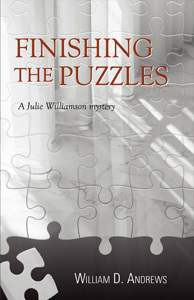 After a much-longer-than-planned break, Julie Williamson is back at work. The central figure in my three mystery novels (Stealing History, Breaking Ground, Mapping Murder), Julie returns in Finishing the Puzzles, just published by Maine Authors Publishing (http://indieauthorbooks.com/fiction/finishing-the-puzzles/). As in the earlier mysteries, Julie is the executive director of an historical society in a small town in western Maine who loves to solve puzzles—jigsaws and crimes. But in the new one the focus of her detecting shifts from historical societies to a continuing care retirement community (CCRC) to which her parents have recently moved to be near her. Who could imagine that such a placid site as a CCRC could be the scene of thefts, financial frauds, and murder? Julie again proves up to the task of solving those crimes.
After a much-longer-than-planned break, Julie Williamson is back at work. The central figure in my three mystery novels (Stealing History, Breaking Ground, Mapping Murder), Julie returns in Finishing the Puzzles, just published by Maine Authors Publishing (http://indieauthorbooks.com/fiction/finishing-the-puzzles/). As in the earlier mysteries, Julie is the executive director of an historical society in a small town in western Maine who loves to solve puzzles—jigsaws and crimes. But in the new one the focus of her detecting shifts from historical societies to a continuing care retirement community (CCRC) to which her parents have recently moved to be near her. Who could imagine that such a placid site as a CCRC could be the scene of thefts, financial frauds, and murder? Julie again proves up to the task of solving those crimes.
How she does so I’ll leave to readers of Finishing the Puzzles. Here I’d like to explain how the book came to be published, a tale that illuminates the, shall we say, mysteries of the current publishing scene. When the press that published my three Julie Williamson mysteries abruptly decided not to publish the fourth, I figured my writing career was over. I had submitted the manuscript in late 2020. In early winter 2021, the editor told me it was scheduled for publication by the end of that year. A few months later the editor wrote to say that because of a backlog and limited staffing at the small press, she had decided not to publish it at all. Of course she said she liked the book, considered it a worthy sequel, regretted that . . . well, yada yada. I was gob smacked. I knew from my royalty statements that my earlier mysteries had sold reasonably well and obviously made decent profits for the publisher. So what was I to do?
As I tried to answer that question, I had to think about what I called above “my writing career.” I’m not a professional writer in the sense that I publish for a living. In my earlier life I had co-written several textbooks on management communication that sold well and earned enough royalties to splurge on such luxury items as a Range Rover and a boat. But my family finances were grounded in the decent salaries my wife and I earned as professors and, later in my case, as an academic administrator. Writing mysteries after early retirement from salaried life was a hobby, the fulfillment of a lifelong interest in the craft of writing, a test to see whether with enough free time I could produce publishable mysteries.
Considering what to do with the newly rejected fourth book was therefore not a question of money but of ego: I wanted to get the book out to satisfy fans who kindly inquired about a sequel—and to satisfy myself that it was worthy. Seeking a new commercial publisher was an obvious possibility, but I didn’t consider the time and energy required to submit a manuscript and await responses to be worth it. The best thing I did was to email several Maine Crime Writers bloggers for advice. The responses were wonderfully prompt, supportive, understanding, and useful. The result was that I decided to enter into what was for me the new world of self or custom publishing. On the strong recommendation of several experienced mystery writers, I contacted Maine Authors Publishing and soon began working with them. And now the book is out. A hearty thank you to those fellow writers who encouraged me and sent me in the right direction. I’m learning about how to market a book unsupported by the staff of a commercial press, a process that will take time and require work.
One lesson learned in this experience is that publishing today is a very different world from the one I had been used to over the 40 years or so in which I wrote textbooks and then mysteries. How quaint it is to recall long and expensive lunches, even for textbook writers, at French restaurants in Manhattan hosted by editors at name-brand publishers that no longer exist! Custom publishing requires a different attitude and new kinds of work. A second and perhaps more pertinent lesson is that persistence is as necessary, and maybe more so, in the new world of publishing as it has always been for would-be writers. Just as you have to simply stick with it as you write, so you have to stick with it as you evaluate new forms of publishing and take on promotional and marketing challenges on your own. All things considered, I wish my former publisher had published the mystery. But here I am in a new world and realizing that the opportunities it offers will present new challenges worth trying to meet. And, best of all, I’m back as a writer. Again, warmest thanks to Maine Crime Writers bloggers whose support and advice made that possible.
June 15, 2022
A Book of the Heart (and a new e-book omnibus)
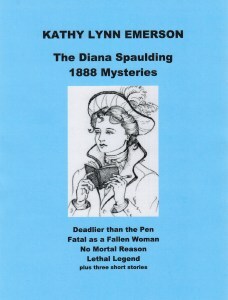 Kaitlyn Dunnett/Kathy Lynn Emerson here, today writing as Kathy and plugging my latest effort at an e-book omnibus edition of backlist titles. I’ve just launched the Diana Spaulding 1888 Mysteries, a collection of four novels and three short stories. My amateur sleuth is a late-nineteenth century journalist who writes for a New York City scandal sheet, the Independent Intelligencer. In the first book in this four-book series, Deadlier than the Pen, Diana is assigned to get an interview with an enigmatic writer of horror stories named Damon Bathory, currently on tour to read selections from his Tales of Terror. She ends up following him to his home in Bangor, Maine (where else would a horror writer live?), a trip that ends up putting her life in danger when they are stranded on a train during the infamous Blizzard of ’88.
Kaitlyn Dunnett/Kathy Lynn Emerson here, today writing as Kathy and plugging my latest effort at an e-book omnibus edition of backlist titles. I’ve just launched the Diana Spaulding 1888 Mysteries, a collection of four novels and three short stories. My amateur sleuth is a late-nineteenth century journalist who writes for a New York City scandal sheet, the Independent Intelligencer. In the first book in this four-book series, Deadlier than the Pen, Diana is assigned to get an interview with an enigmatic writer of horror stories named Damon Bathory, currently on tour to read selections from his Tales of Terror. She ends up following him to his home in Bangor, Maine (where else would a horror writer live?), a trip that ends up putting her life in danger when they are stranded on a train during the infamous Blizzard of ’88.
I initially described my work-in-progress as “Nellie Bly meets Stephen King” and it owes a lot to both the so-called modern gothic novels I loved reading when I was in my twenties and the cozy mysteries I later embraced. The Drood Review made me very happy by understanding what I was trying to do, writing that “Emerson plays with the atmosphere and conventions of gothic romantic suspense” and concluding that it is “a very enjoyable read that will leave you eagerly awaiting Diana’s next adventure.” The other three novels (Fatal as a Fallen Woman, No Mortal Reason and Lethal Legend) are traditional historical mysteries. Diana and Ben Northcote (aka Damon Bathory) solve them as a sleuthing team.
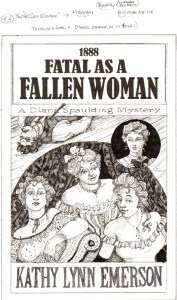
rough sketch for cover art NOT chosen for FATAL AS A FALLEN WOMAN
The novel that eventually became Deadlier than the Pen was one of those “books of the heart” most writers are faced with at some point in their careers—the story that insists on being written, even when publication by a royalty-paying traditional publisher seems highly unlikely. From 1991 until 2003, the manuscript went through many versions and several titles and accumulated rejections for all of them. My agent at the time was unenthusiastic. That didn’t stop me from starting work on a sequel. I was ecstatic when both books and two more in the series finally found a home with a small press that was just starting up. Sadly, although the books were beautifully produced and got good reviews, a small press run guaranteed that sales would also be limited. Still, the books were out there. That made me very happy.
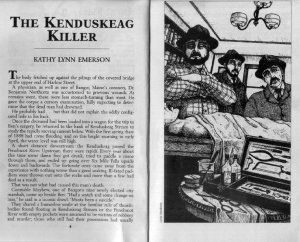 Jumping ahead several years, the small press shut down, the rights returned to me, and I reissued them as individual e-books. Meanwhile, a short story that takes place between the first and second books (“The Kenduskeag Killer”) was published in Alfred Hitchcock Mystery Magazine. A second short story (“The Tell-Tale Twinkle”) taking place in the same timeframe, was published as a special edition chapbook at Malice Domestic in 2014, the year I was the Malice Guest of Honor.
Jumping ahead several years, the small press shut down, the rights returned to me, and I reissued them as individual e-books. Meanwhile, a short story that takes place between the first and second books (“The Kenduskeag Killer”) was published in Alfred Hitchcock Mystery Magazine. A second short story (“The Tell-Tale Twinkle”) taking place in the same timeframe, was published as a special edition chapbook at Malice Domestic in 2014, the year I was the Malice Guest of Honor.

original cover art for NO MORTAL REASON by Linda Weatherly S
I still love these books and these characters and the nice part of being semi-retired, and no longer subject to any publisher’s whims, is that I can spend time playing with my backlist. For the last few months I’ve been rereading these books and stories, making a few minor adjustments to make them flow more smoothly, and putting them together for this omnibus edition. The plots take Diana from New York City to Maine; then out to Colorado when her mother is accused of murdering her father; back to New York state to meet family members she never knew she had (who just happen to live in the same area where I grew up and where I, as Kaitlyn, set my Deadly Edits series); and finally back to Maine for a deadly archaeological dig on a fictional island off the coast. Writing Lethal Legend required a research trip to Islesboro and an overnight stay in an historic mansion. Such a hardship!
It is my hope that the Diana Spaulding 1888 Mysteries, reasonably priced at $9.99 (the same as each book in my three-volume The Face Down Collection), will draw new readers to the series. I don’t expect massive sales, but it pleases me to know that what began as a book of the heart will live on.
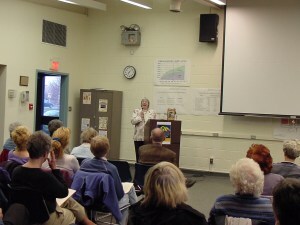
talking about DEADLIER THAN THE PEN in 2004 at the library in Clifton Park, NY
The e-book collection is available in Kindle, Nook, iBook, and Kobo formats. Some, but not all, links to buy can be found here: https://books2read.com/u/3y1M1n
And for those who prefer to read print versions, yes, I do still have copies of the original small press editions and will happily sell them to you. You can reach me here
Happy Reading!
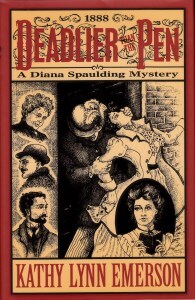
hardover edition of DEADLIER THAN THE PEN
Kathy Lynn Emerson/Kaitlyn Dunnett has had sixty-four books traditionally published and has self published others, including several children’s books. She won the Agatha Award and was an Anthony and Macavity finalist for best mystery nonfiction of 2008 for How to Write Killer Historical Mysteries and was an Agatha Award finalist in 2015 in the best mystery short story category. She was the Malice Domestic Guest of Honor in 2014. Her most recent publications are The Valentine Veilleux Mysteries (a collection of three short stories and a novella, written as Kaitlyn) and I Kill People for a Living: A Collection of Essays by a Writer of Cozy Mysteries (written as Kathy). She maintains websites at www.KaitlynDunnett.com and www.KathyLynnEmerson.com.
Lea Wait's Blog
- Lea Wait's profile
- 509 followers




